Learning scales helps you to become a more complete musician. As a flute player and teacher with over 14 years’ experience, I’ve taught my fair share of scales. Here are fingering charts for all flute natural minor scales and my top tips for success!
Flute Natural Minor Scales
A Natural Minor
Notes: A, B, C, D, E, F, G, A
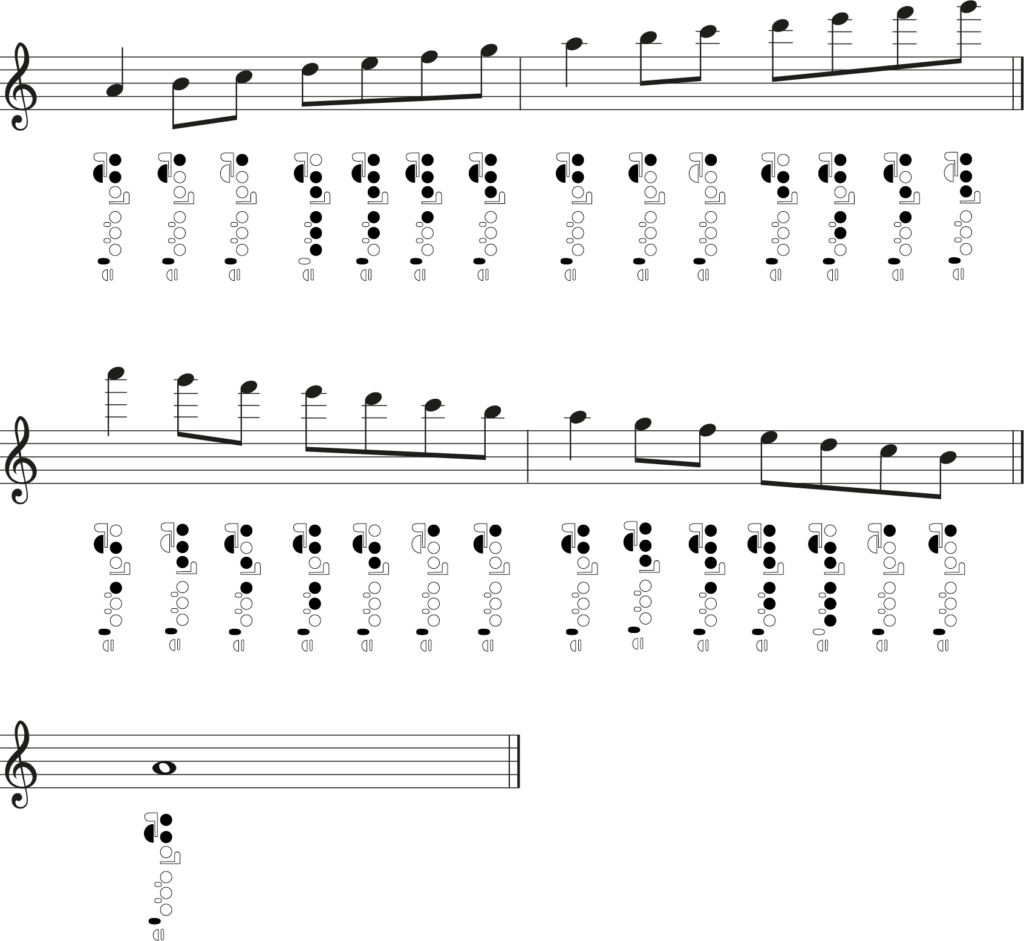
Top tips for playing A natural minor:
- Smooth Transition Between Notes: Focus on the transition from B to C and E to F, as these can be tricky due to the minimal finger movement required. Practice these transitions slowly, emphasizing legato playing to ensure smoothness, then gradually increase the tempo as you gain fluency.
- Maintaining Intonation on High Notes: The higher octave, especially notes like A and B, can be prone to sharpness. Use long tone exercises to practice these notes, paying close attention to your tuner to adjust your embouchure and air support for accurate intonation.
- Consistent Tone Quality Across Octaves: Achieving a uniform tone from the low A to the high A involves careful control of air support and embouchure. Practice octave jumps, focusing on keeping a steady airstream and a relaxed embouchure to maintain an even tone throughout the scale.
E Natural Minor
Notes: E, F#, G, A, B, C, D, E

Top tips for playing E natural minor:
- Accurate Low Note Articulation: In the E natural minor scale, transitioning from open E to F# and B to C can be challenging due to the quick change in fingerings. Practice these transitions slowly, focusing on clean articulation and precise finger movement, then gradually increase speed while maintaining clarity.
- Balancing Intonation in Mid-Range: The notes G, A, and B in the middle octave can sometimes sound out of tune due to the natural tendencies of the flute. Use a tuner to practice these notes individually, adjusting your embouchure to correct pitch, and then play them within the context of the scale to ensure consistent intonation.
- Even Tone Through Register Changes: Moving from the lower register (E, F#, G) to the higher register (A, B, C, D) and back can challenge tone consistency. Practice playing across the registers with a focus on steady air support and minimal embouchure adjustments to achieve a smooth, even tone across the entire scale.
B Natural Minor
Notes: B, C#, D, E, F#, G, A, B
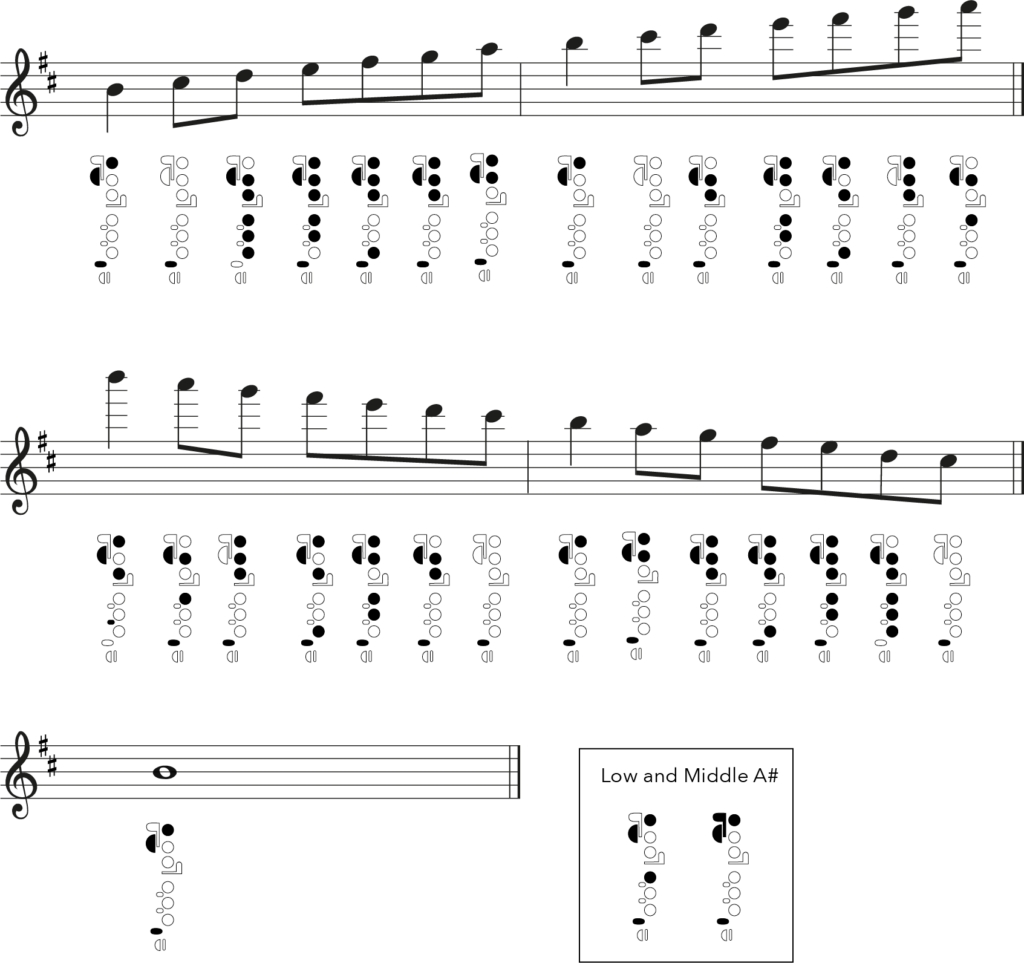
Top tips for playing B natural minor:
- Fingering Precision for C# and D: The transition between C# and D requires precise fingering, especially when moving quickly. Practice these notes slowly to ensure clean articulation, gradually increasing the tempo while maintaining accuracy and smoothness in the transitions.
- Intonation on High Notes: High F# and G can be prone to sharpness in the B natural minor scale. Use a tuner to practice these notes in isolation, focusing on adjusting your embouchure and air support to achieve correct pitch, then incorporate them into the scale to ensure they blend well with the other notes.
- Maintaining Tone Quality in Lower Register: The lower notes (B, C#, D) demand focused air support to produce a full, rich tone. Practice long tones on these lower notes to improve tone quality, then play the scale slowly, focusing on producing a consistent tone across the scale, especially as you transition from lower to higher notes.
F Sharp Natural Minor
Notes: F#, G#, A, B, C#, D, E, F#

Top tips for playing F# natural minor:
- Smooth Transition Between High Notes: The leap from E to F# and the subsequent notes up to the high C# can be challenging due to the fingerings and the natural tendency for intonation issues. Practice these transitions slowly, focusing on legato playing to ensure smoothness, then gradually increase the speed as you become more comfortable.
- Correcting Intonation for A and B: The A and B in the middle octave can sometimes be sharp or flat in the context of the F# natural minor scale. Use a tuner to work on these notes individually, adjusting your embouchure to fine-tune their pitch. Practice these notes within the scale, ensuring they are in tune with the rest of the notes.
- Consistent Tone Quality Across Octaves: Achieving an even tone from the lower F# to the higher octaves involves careful control of air support and embouchure adjustments. Practice octave leaps, focusing on keeping a steady airstream and a relaxed embouchure to maintain an even tone across the entire range of the scale.
C sharp Natural Minor
Notes: C#, D#, E, F#, G#, A, B, C#

Top tips for playing C# natural minor:
- Accurate Fingering for High Notes: Navigating the high notes, particularly the transition from G# to A and the upper octave C#, requires precise fingerings to maintain clarity and smoothness. Practice these high transitions slowly, focusing on accurate finger placement, and gradually increase speed while ensuring each note is articulated cleanly.
- Tuning the Lower Octave: The lower octave, especially E and F#, can be prone to intonation issues in the C# natural minor scale. Use a tuner to practice these notes in isolation, making slight embouchure adjustments to correct pitch. Then, integrate these notes into the scale, focusing on maintaining consistent intonation throughout.
- Maintaining Even Tone Across Registers: Transitioning from the rich, lower register to the brighter, higher register and back can challenge the uniformity of your tone. Focus on steady air support and minimal embouchure adjustments as you move through the scale.
G Sharp Natural Minor
Notes: G#, A#, B, C#, D#, E, F#, G#

Top tips for playing G# natural minor:
- Efficient Fingering for E# to F#: In the G# natural minor scale, transitioning smoothly between E# (enharmonically F) and F# is crucial for maintaining the scale’s fluidity. Practice these transitions slowly, focusing on the minimal yet precise finger movement required, then gradually increase the tempo while ensuring clarity and smoothness.
- Intonation on High Notes: The high G# and A# notes can be particularly challenging for intonation, tending to sound sharp. Use a tuner to work on these notes individually, adjusting your embouchure and air support for accurate pitch, then practice them within the context of the scale to ensure they blend well with the overall tonality.
- Consistent Tone Quality Across the Scale: Achieving a uniform tone from the lowest G# to the highest notes involves careful control of air support and embouchure. Practice the scale in sections, focusing first on lower octaves and then on higher ones, aiming for a steady airstream and a relaxed embouchure.
D Sharp Natural Minor
Notes: D#, E#, F#, G#, A#, B, C#, D#
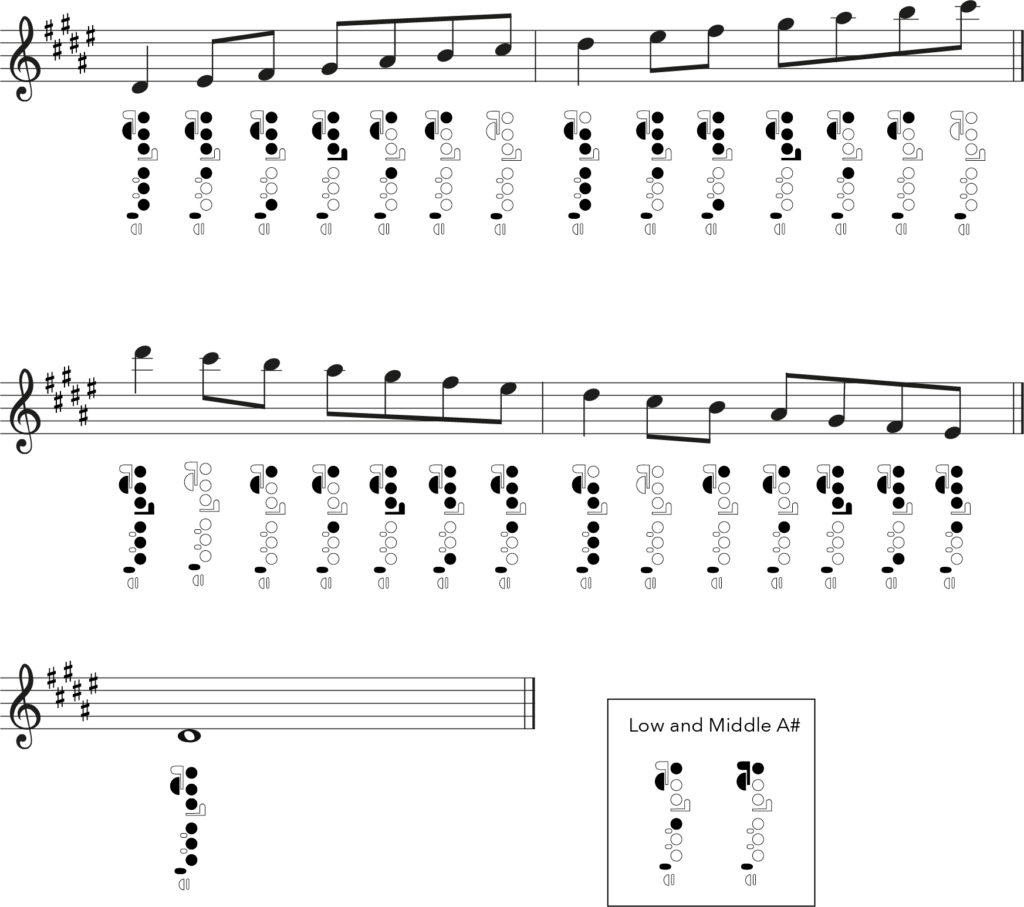
Top tips for playing D# natural minor:
- Smooth Transition Between High Notes: For the D# (or E♭) natural minor scale, focus on the transitions between high D# (E♭) to E# (F), where fingerings can be complex. Practice these sections slowly to ensure each note is clear and the transition is smooth, then gradually increase the tempo while maintaining precision.
- Maintaining Intonation on Lower Notes: The G# (A♭) and A# (B♭) in the lower octave can be prone to intonation issues, often sounding flat. Use a tuner to practice these notes, adjusting your embouchure to fine-tune their pitch. Practice integrating these adjustments into the scale to maintain consistent intonation.
- Consistent Tone Quality Through Octave Leaps: Moving from the lower D# (E♭) to the higher octaves requires careful control of air support and embouchure to keep a consistent tone. Focus on smooth, controlled air flow and minimal embouchure changes during octave transitions.
D Natural Minor
Notes: D, E, F, G, A, B♭, C, D

Top tips for playing D natural minor:
- Clean Articulation Between B♭ and C: In the D natural minor scale, transitioning smoothly between B♭ and C is essential for maintaining the scale’s fluidity. Practice this segment slowly, focusing on precise finger movements to ensure each note is articulated cleanly. Gradually increase the tempo while keeping the transition smooth.
- Intonation on High Notes: The high A and high D notes can be challenging for intonation, with a tendency to sound sharp. Use a tuner to work on these notes individually, focusing on adjusting your embouchure and air support to achieve accurate pitch. Then, practice these notes within the context of the scale to ensure they blend well with the overall tonality.
- Even Tone Quality Across the Scale: Achieving a consistent tone from the lower D to the higher D involves careful control of air support and embouchure. Practice the scale in sections, focusing on maintaining a steady airstream and a relaxed embouchure across the entire range.
G Natural Minor
Notes: G, A, B♭, C, D, E♭, F, G
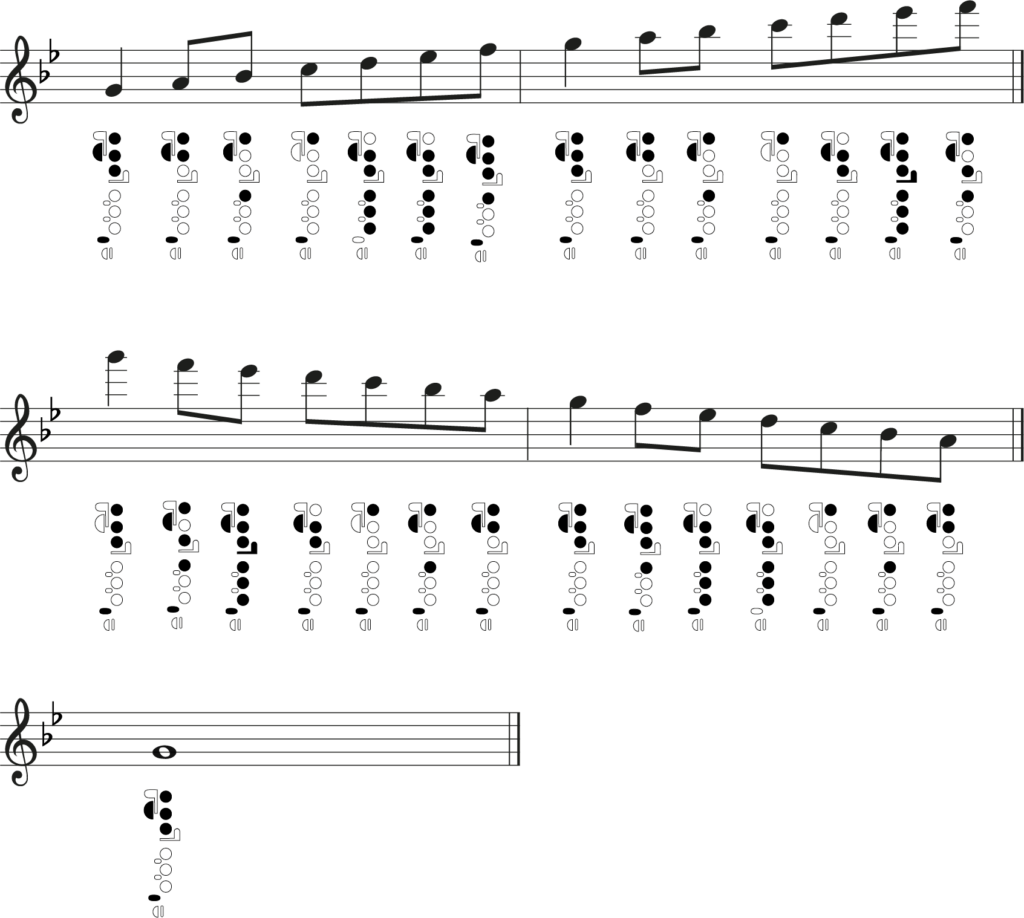
Top tips for playing G natural minor:
- Accurate Fingering for B♭ to C Transition: The G natural minor scale includes a crucial transition from B♭ to C, which requires precise fingering to maintain fluidity. Practice this transition slowly, focusing on clean finger movements and ensuring each note sounds clearly. Gradually increase the speed while maintaining the transition’s smoothness.
- Intonation on High G: The high G note can be challenging in terms of intonation, with a tendency to sound sharp. Use a tuner to practice this note in isolation, focusing on adjusting your embouchure and air support to correct the pitch. Then, integrate this practice into the scale, ensuring the high G blends well with the other notes.
- Consistent Tone Quality Across Registers: Achieving an even tone quality from the lower G to the higher G requires controlled air support and a stable embouchure. Focus on smooth transitions across the registers, practicing the scale in sections and then as a whole.
C Natural Minor
Notes: C, D, E♭, F, G, A♭, B♭, C
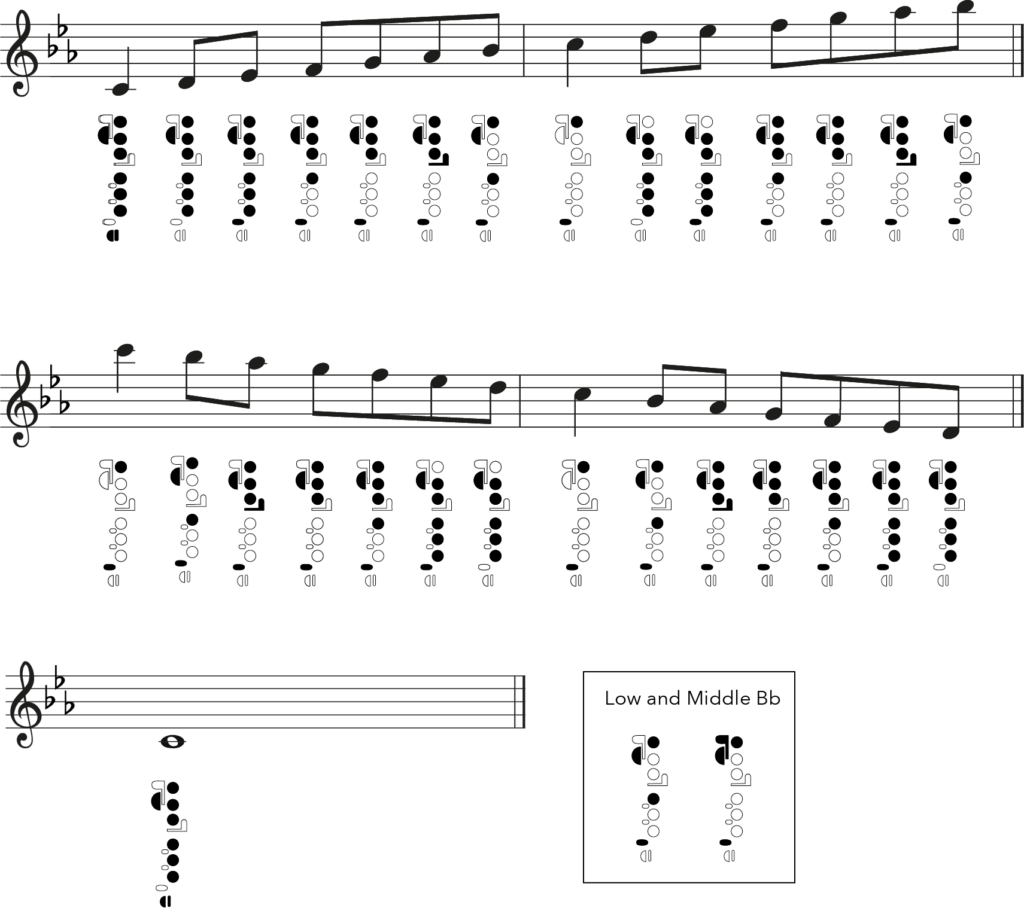
Top tips for playing C natural minor:
- Smooth Transition Between G and A♭: In the C natural minor scale, moving cleanly between G and A♭ is vital for maintaining the scale’s flow. Practice this transition slowly to ensure precise finger movement, then gradually increase speed while keeping the notes connected and smooth.
- Maintaining Intonation on High Notes: High E♭ and high G can be prone to sharpness. Use a tuner to work on these notes individually, focusing on embouchure adjustments to correct pitch. Practice these high notes within the scale context to ensure they blend seamlessly with the surrounding notes.
- Even Tone Across Octave Leaps: Transitioning smoothly from the lower C to the higher C, and maintaining a consistent tone throughout the scale, requires careful air support and embouchure control. Practice octave jumps with a focus on steady airflow and minimal embouchure change.
F Natural Minor
Notes: F, G, A♭, B♭, C, D♭, E♭, F
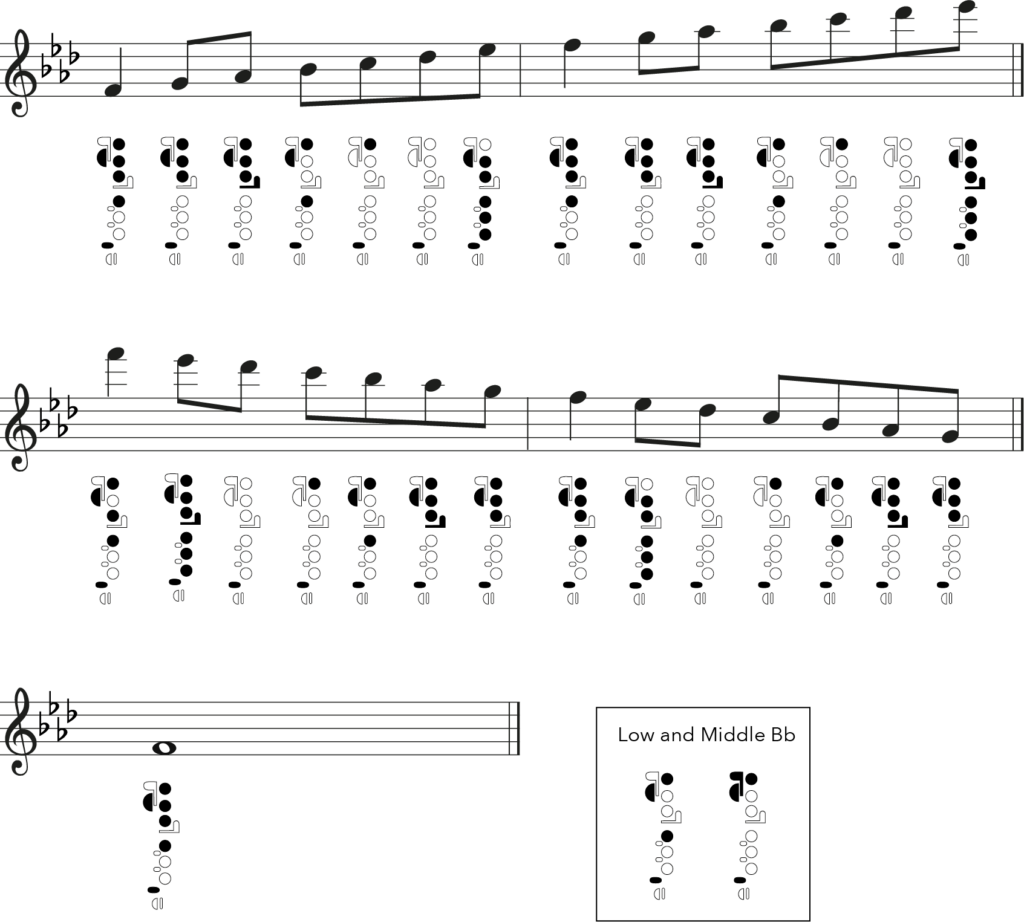
Top tips for playing F natural minor:
- Accurate Fingering for B♭ to C Transition: In the F natural minor scale, the transition from B♭ to C is key for smooth scale execution. Practice this segment slowly, focusing on precise finger movements to ensure each note is articulated cleanly, then gradually increase the tempo while keeping the transition smooth.
- Intonation on Middle and High Ab: The Ab notes, particularly in the middle and high octaves, can challenge intonation, often sounding flat. Use a tuner to practice these notes in isolation, adjusting your embouchure to fine-tune their pitch. Then, integrate these adjustments into playing the scale to maintain consistent intonation.
- Consistent Tone Quality Through Registers: Achieving an even tone quality across the scale, especially when transitioning from the lower F to the higher F, involves controlled air support and stable embouchure. Focus on maintaining a steady airstream and a relaxed embouchure throughout the scale.
B flat Natural Minor
Notes: B♭, C, D♭, E♭, F, G♭, A♭, B♭
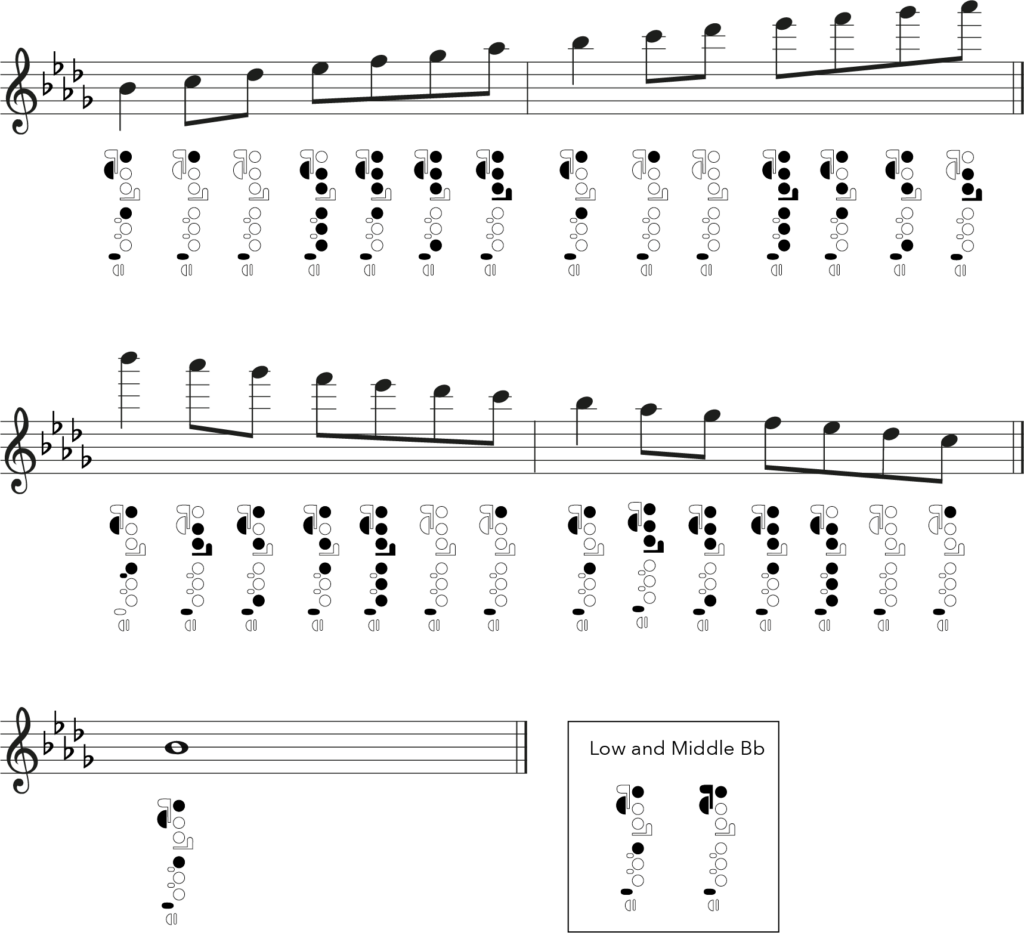
Top tips for playing Bb natural minor:
- Smooth Transition Between E♭ and F: In the B♭ natural minor scale, the transition from E♭ to F can be tricky due to the small finger movements required. Practice this segment slowly, focusing on precise finger movements to ensure a clean and connected transition, then gradually increase the speed while maintaining smoothness.
- Intonation on High Notes: The high B♭ and high D♭ notes can be challenging for intonation, with a tendency to sound sharp. Use a tuner to practice these notes in isolation, focusing on embouchure adjustments to achieve the correct pitch. Then, integrate these notes into the scale, ensuring they blend seamlessly with the overall tonality.
- Consistent Tone Across Octave Leaps: Achieving a uniform tone from the lower B♭ to the higher B♭ requires careful air support and embouchure control. Focus on smooth transitions across registers, practicing the scale in sections and aiming for a seamless, consistent tone throughout.
E flat Natural Minor
Notes: E♭, F, G♭, A♭, B♭, C♭, D♭, E♭

Top tips for playing Eb natural minor:
- Accurate Fingering for G♭ to A♭ Transition: The E♭ natural minor scale requires careful attention during the transition from G♭ to A♭, as this step can impact the fluidity of the scale. Practice this segment slowly, focusing on clean and precise finger movements, then gradually increase the speed while ensuring the transition remains smooth.
- Intonation on Lower and High B♭: The B♭ notes, especially in the lower and higher octaves, can be prone to intonation issues, often sounding flat. Use a tuner to practice these notes individually, adjusting your embouchure to fine-tune their pitch. Then, incorporate these notes into the scale practice, focusing on maintaining consistent intonation across the scale.
- Even Tone Quality Across Octaves: Maintaining a consistent tone quality when transitioning from the lower E♭ to the higher E♭, and through the scale’s range, is crucial. Focus on controlled air support and minimal embouchure adjustments across octave leaps.
What’s next….?
- Learn all harmonic minor scales for flute
- Learn flute major scales
